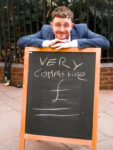I didn’t look for mindfulness. To be honest, I wasn’t particularly interested in it. I came across it almost accidentally and with a sceptical attitude. Yet it deeply influenced me, both personally and professionally and, in many ways, I think that I will never leave apart from it, even if I wanted. It all started four years ago. I lived in the nuns’ quarter of a Buddhist temple in Thailand for almost two months.
I had been travelling around South-East Asia when the news reached me that a close friend of mine had unexpectedly died. I was confused and frozen, unable to go ahead with my travels. When I discussed the situation with a Thai friend, she suggested that I should go to Bangkok and visit the monks at the Buddhist temple that she regularly attends. I confess that I was sceptical about taking a mystic approach to my problem, but I was also stuck, and far from home, so I decided that talking with a monk probably wouldn’t hurt, and therefore off I went. I took a train from Chiang Mai and arrived in Bangkok early in the morning. The monastery was a vast complex of around 20 temples and I wandered until I found a large prayer room where a group of devotees dressed in white clothes were sitting on the floor facing a Buddha shrine. A monk noticed me and, with an almost imperceptible nod, asked me to wait. When the gathering finished their prayers, the monk came to talk with me. Our conversation was very succinct. He asked me how I had found the place and what brought me there. I briefly told him about my friend’s suggestion. He nodded and asked me to observe what he was going to do. He started walking very slowly along an imaginary line. He then asked me to join, after having instructed me to keep my mental focus on the physical sensations of my feet. I didn’t know that yet, but I was starting to learn the fundamentals of Vipassana Meditation.
For over a month after that morning, I submerged myself into the monastic life, living with the nuns according to their strict routine and precepts, and practicing their techniques of meditation and mindfulness. At first, I had expressed doubts about the proposal of staying there – I wasn’t religious – but the monk replied that one of the missions of the temple was to pass on their teaching because the world needed it, not only religious people. He also added that I could use the same techniques for many other reasons, not only for personal matters. When I told him that I was a management consultant, the monk smiled and said that the corporate world needed as much meditation as individuals. We never discussed why – but I was to find out by myself. During the time spent there I focused on my progress in the meditation techniques and also on controlling the temptation to drift towards a mystic perspective. The monk strong rejected these ideas. He always kept a practical view, certainly more down to earth than many Western ‘gurus’. I truly appreciated that. Vipassana Meditation alternates walking and sitting. The time of non-meditation is dedicated to practicing mindfulness. The mental exercise is exhausting. For over 15 hours a day I nuns and monks train their brain to keep a difficult balance between focusing on the sensation of the feet or on the breath, noticing and let go of verbalised thoughts, and at the same time keeping all the senses aware and awake but oblivious to their incitements. Controlling the excruciating muscular pain constitutes another important component of the training. However, while I was there I wasn’t aware that far more significant changes were occurring to my brain. I left the temple early in the morning. When I crossed main door of the complex, from which I had entered almost two months earlier, the Bangkok that I saw in front of me was completely different from the one that I thought I knew. My senses were enhanced as if I had become a superhuman. My vision had become wider. Cleansed from pre-concepts and conditioning my eyes were left free to observe far more details and colours. Also my sense of smell and hearing sent back an unusual amount of details. For a moment, I felt overwhelmed by a feeling of wonder, but as I kept walking, I started noticing what exactly had changed. Before, my vision and the other senses were attracted by specific objects and items, while now they seemed equanimous to whatever I encountered on my path. For example, when I entered, the temple in Bangkok seemed heavily populated by people who had some resemblance with the friend who had died. Now I realised that in actual fact my eyes and senses had been highly vigilant to capture and put to my attention anything that would remind me of her. The way a person walked, the shape of a nose, an object in a shop window that she would have liked. I therefore realised that before my experience at the monastery, I didn’t actually see Bangkok: I saw myself and my thoughts reflected onto Bangkok. That was a real moment of enlightenment to me.
My mind immediately went back to a research that I had completed only two months earlier. It was a qualitative study on work-life balance. Working jointly with the psychologist M.L. Virviescas, I had coded, grouped and developed logic classifications of around 12 hours of transcribed audio material. We had followed a strict protocol and adopted a number of de-biasing techniques, and the quality of our work must have been good, since it had received a prize from the London School of Economics ([1]). But as I was walking towards Bangkok station I was suddenly plunged into self-doubt. To which extent our classifications mirrored our own thoughts and opinions, just as Bangkok was the mirror of my worries. Would the results change, had I classified that material after a month spent meditating? I still don’t have the answers, but I hope that universities will invest some resources to test to which extent meditation retreats can improve the quality of social research. These reflections have also deeply influenced how I now approach my work as a manager and consultant.
Long before going to Bangkok I was aware of the influence of bias and cognitive manipulation in the decision-making process and on the outcomes of performance appraisals ([2]). It has however been my ‘superhuman’ insight that permanently marked my self-consciousness of it. But through this experience I have also learnt how difficult is to keep vigilant. Mindfulness requires a strict verbal and non-verbal silence. Nuns and monks follow a long number of precepts that, together with their strict routine, support the correct state of mind. Even wearing a bracelet, or looking a person in the eye breaks the balance. As the monk told me once: “Notice how the statues of Buddha represent him looking at the ground: he’s practicing mindfulness”. Therefore, I don’t embrace the idea that mindfulness can be easily injected in the corporate world because this cannot offer the conditions that allow to replicate the deep state of mindfulness lived in a temple by monks and nuns. On the other side, I don’t embrace the idea either that we should ignore the extent to which biases impair our observations, and ultimately our decisions. That image of Bangkok when I left the temple resurfaces every time I consider HR issues and discuss strategies and consider leadership programmes. It pushes me to constantly challenge my own perceptions, to keep my senses open, to embrace challenge, and ultimately to always find ways in which my view is balanced by someone else’s view.
In other words, this experience reinforces the constructivist view that the value of an organisation lies in its collective knowledge. I know that most managers will never fully recognise the extent of their own biases unless they submerge themselves in an experience as all-absorbing as the one I did, at least once. But I also know that if they are collectively aware and accept that there is a mirror screen between themselves and the world, then their ability to compromise, as well as their flexibility and openness to the viewpoint of other people and functions, and ultimately the quality of their judgments, will increase. Maybe what the monk meant by saying that organisations needed mindfulness was not that they should be transformed in Buddhist monasteries, but that those that embrace and embed this view in their organisational culture can still largely benefit from their valuable teaching.
[1] A.P. Usai, M.L. Virviescas (2011) ‘Work-Life Unbalance and the Role of Organisational Border-Keepers in Understanding Turnover Intentions: a Qualitative Study of Recruitment Consultants in the UK’, Dissertation for the Masters in HRM, London School of Economics, London.
[2] R. Folger, R. Cropanzano (1998), ‘Organizational Justice and Human Resource Management’, Thousand Oaks, Sage Publications, London.
First and foremost, independence is the core strength of theHRDIRECTOR. Unlike many competitor publications in the hr sector, we do not publish paid for articles. When we commission an article, the journey from synopsis to completion is through carefully considered collaboration with the author, both parties clear about the main objectives; to deeply explore the subject, and always to bring a new and informative perspective to the page. With the needs and expectations of the reader firmly in mind, the magazine has maintained unrivalled standards and enjoys an enviable integrity.
To support our subscription campaign, each month we will be sharing four, carefully-chosen articles from the latest issue of our flagship publication, which exemplify the high standards we strive to achieve. We hope you enjoy reading them and decide to become one of our valued subscribers.
To view our subscription options, please click here.







